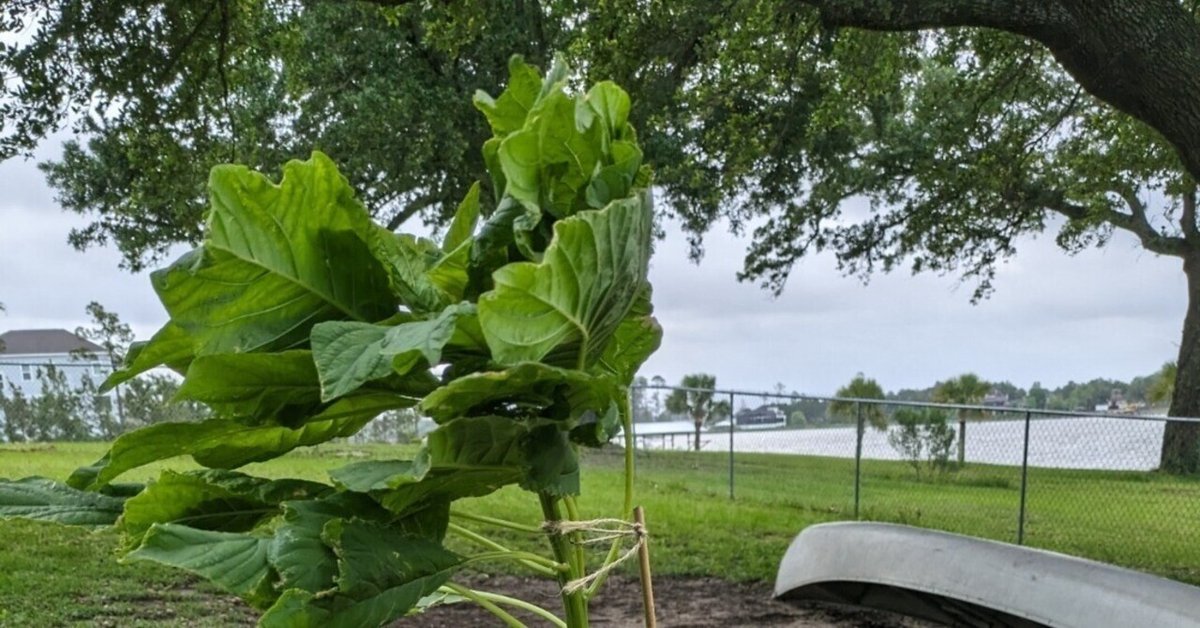
ごぼうの話
アメリカで日本料理というと「すし (カリフォルニアロール)」「やきそば(中華風)」などが人気なわけですが、やはり純日本人のわたしとしては、きんぴらや煮物などの家庭料理が恋しくなります。それで、2か月に1回くらいはアジアスーパーに行って、ゴボウや里芋、レンコンなどを仕入れてくるのですが、鮮度が悪い割に値段が高くて、毎回悲しくなってしまいます。そこで、昨年から 本格的に始めた家庭菜園にゴボウも加えることにしました。

普通の園芸店ではゴボウの種が入手できないので、オンラインで日本の野菜の種を扱っているKitazawa Seed Companyという店を見つけて「サラダ娘」という比較的作りやすいゴボウを購入。このKitazawa Seed Company は、日系アメリカ人が1917年に創業した歴史のある会社のようです。昔アメリカに移住した人も、なんとか和食がたべられるようがんばったんだろうなぁと思わず思いを馳せてしまいます。
さて、種を購入したのが8月くらいだったので、秋まきを考えていたのですが、去年のミシシッピはいつまでも暑さがつづき、結局種まきは3月初旬になりました。
種まきからしばらくしてもなかなか芽が出ないので心配していましたが、2,3週間してようやくぴょこっと黄緑色のかわいい芽が出ました。

私 「これって雑草かな…?」
主人 「いや、ここでこんな葉っぱ見たことないから絶対ごぼうだよ。」
私 「がんばって育つといいね。」
主人 「うん、ごぼうがんばって」
私たちの願いが叶って、まるで昔話のように「ごぼう」はすくすく育ち始めました。
すくすくすくすく …え、なんだかすくすく育ちすぎでは???

ついに風が強い日には支柱を立てないといけないくらい高くなりました。ゴボウって、こんなに高い?栽培方法を調べたときの絵では低そうだったけど?不思議に思い、Youtubeでほかの方たちの栽培の様子を何度もチェック。どう考えても家のは高すぎるし、葉っぱもなんか違う。
私 「ねえねえ、なんかうちのゴボウっぽくない」
主人「たぶんちがう種類だろう」
そんなこんな言っているある日、余りの風の強さで、一番細くてしい物がついにおれてしまいました。折れてしまってはもう育つ見込みがない、と主人が引っこ抜いてみると弱弱しい白い根っこが現れました。

あれ、何か想像してた根っこと違う…
ついに私たちはKitazawaにメールで問い合わせをすることに。
私 「初春にゴボウの種をまきまして、とてもよく育っていたんですが残念 ながら強風で一本折れてしまいました。それで土から抜いてみたんですが、どうも根っこが日本のゴボウのようには見えないんです…。」
Kitazawa 「 まだ十分に育ってないですね。初春にまいたのであれば、秋まで待たないといけません。花の咲く前が収穫時期ですよ。」
私 「 わかりました。では、もう3,4か月待ってみようと思いますが、すでに茶色い花のようなものがついてるんですよね。」


Kitazawa 「 写真をありがとうございます。お客様のおっしゃる通り、それはゴボウではありません。自生のアマランサスのようです。おそらくゴボウは発芽しなかったと思われます。」
なんと、私たちが育てていたのは、ゴボウではなくアマランサスだったのです…!主人が去年の秋に撒いて全く芽が出ずにあきらめていたアマランサスが変なタイミングで芽を出したのでした。
ちょっと違いますが、自分の子供だと思って育てていたら、実はカッコウを育てていた鳥みたいな気分です。

その後のkitazawaseedの対応はすばらしく、早速代替えとして、他の似たような種を送ってくださるとのこと。おまけに花の種も追加してくださいました。明日くらいには届くようです。
またどうなるか今後書いていきたいと思います。
The Tale of the Gobō
When it comes to Japanese cuisine in America, sushi and (Chinese-style) yakisoba are popular. But as a Japanese person, I miss home-cooked meals like kinpira (braised burdock root) and nimono (simmered vegetables etc.). I go to the Asian supermarket about once every two months to buy gobō, taro, and lotus root, but I’m always disappointed because they are relatively expensive but aren’t fresh.
Therefore, we added gobō to the list for our garden that we started working seriously on last year.
We couldn’t get any gobō seeds at regular garden stores, but we went online and found this company called Kitazawa Seed Company that has the seeds for Japanese vegetables. There, we bought “Sarada Musume,” a variety of gobō that is relatively easy to grow.
Established by a Japanese-American in 1917, Kitazawa has a long history. I imagine that Japanese immigrants were eager to eat Japanese foods and work hard. It makes me feel nostalgic.
We bought the seeds around August, and we were thinking to do a fall planting. But the hot weather stuck around forever last year, so we ended up planting the seeds in early March.
We waited a bit and they didn’t come up, so we were worried. But a few weeks after we planted them, some cute light-green sprouts appeared.
Me “Is this a weed…?”
Husband “No, I’ve never seen leaves like this here. They are definitely gobō.”
Me “I hope they grow well.”
Husband “Yeah. Good luck Gobō!”
Like a wish being granted in a fairy tale, they grew rapidly.
They grew and grew and grew…but wait, did they grow too much??
Eventually, the plants got so tall that we had to support them against the strong wind.
Are gobō supposed to be this big? When I looked up how to grow it, the pictures seemed shorter.
I thought this was weird, so I watched a bunch of videos on YouTube to see what it looked like when it was growing. Ours was just way too tall, plus its leaves looked different somehow.
Me “Hey, ours don’t look like gobō.”
Husband “Maybe it’s a different variety.”
One day, while we were discussing this, some strong wind snapped the weakest plant’s stem. My husband said that it wouldn’t grow anymore, so he pulled it up. That’s when we saw its very frail white roots.
Hmm, this wasn’t what we expected…
We finally decided to email Kitazawa about it.
I told them that we planted burdock (gobō) seeds in early spring of this year and they were growing very well, but unfortunately one of them broken due to strong wind. But when we pulled it out, it didn’t look like the burdock roots we have in Japan…
They replied:
“The burdock root isn’t mature enough for harvesting. If you plant them in early spring, they won’t be ready until fall. The roots require sufficient time to develop, and it’s best to harvest them before the plant begins to flower.”
I told them, “Okay, we will wait a few more months. But it seems that some already made some brown flowers.”
“You’re correct, and thank you for sharing these images. It appears that the plant shown is not burdock but rather amaranthus, likely a volunteer plant that sprouted near where you planted the burdock seeds. It seems probable that the burdock seeds did not germinate as expected.
What? We were growing amaranth, not gobō!!
My husband planted them last year and they didn’t sprout at all. But then they came up at a weird timing
It’s a bit different, but this reminds me of the bird that is fooled into raising a cuckoo chick believing that it’s their own offspring.
The customer service from Kitazawa was amazing. They said they will send us some similar alternatives and also throw in a pack of flower seeds. They might get here tomorrow.
I will update here again.
